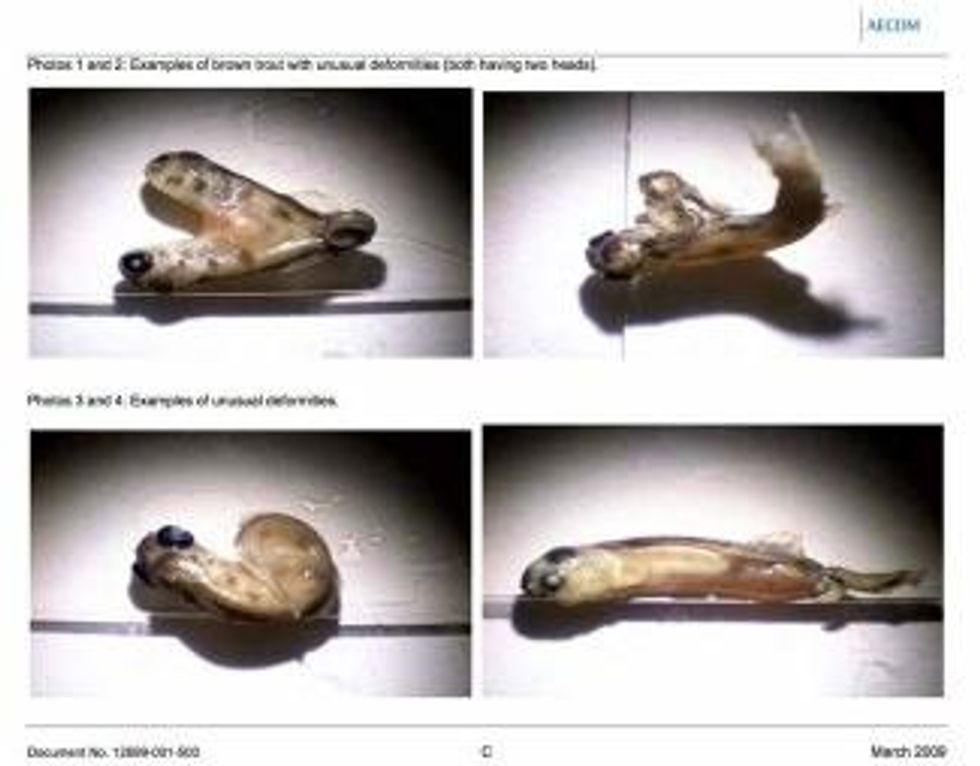The Tale of J.R. Simplot's Two-Headed Trout
The corporate propensity for rationalizing the irrational in the pursuit of profit appears to be boundless.

Consider J.R. Simplot, a giant conglomerate whose mining operations in Idaho have grossly polluted creeks with selenium, a highly toxic metal. But Simplot's scientists rationalized the corporation's dirty deed with a 1,000-page study asserting that even though the selenium contamination of creeks was well above levels allowed by environmental law, the water remained "safe" for fish.
Tucked back in the appendix of Simplot's "study," however, were a few photographs that vividly depicted the screaming irrationality of the corporation's safety claims. The most stunning photo was of a two-headed baby trout produced by Simplot's pollution of area creeks. It was not the only sickening deformity caused by the selenium - other trout had facial, fin, and egg disfigurements.
These grotesque mutations led to calls for an independent agency to conduct a full scientific review of Simplot's 1,000-page study. At Sen. Barbara Boxer's request, this was done by the Fish and Wildlife Service, which issued a scathing report in January that bluntly branded the corporate study "biased." For example, Simplot systemically understated the deformity rate of baby fish in the creeks - it's not 20 percent that are deformed, but 70 percent.
Asked about this rather broad discrepancy, a Simplot vice-president could only grump that the Fish and Wildlife review was "totally outside the regulatory process." Well thank goodness for that! As another independent toxicology expert says, "I have seen lots of malformed baby fish, but never one with two heads. We need to be careful here."
Yes, let's. In fact, let's stop swallowing any irrational rationalizations by corporations that pollute for profit.
An Urgent Message From Our Co-Founder
Dear Common Dreams reader, The U.S. is on a fast track to authoritarianism like nothing I've ever seen. Meanwhile, corporate news outlets are utterly capitulating to Trump, twisting their coverage to avoid drawing his ire while lining up to stuff cash in his pockets. That's why I believe that Common Dreams is doing the best and most consequential reporting that we've ever done. Our small but mighty team is a progressive reporting powerhouse, covering the news every day that the corporate media never will. Our mission has always been simple: To inform. To inspire. And to ignite change for the common good. Now here's the key piece that I want all our readers to understand: None of this would be possible without your financial support. That's not just some fundraising cliche. It's the absolute and literal truth. We don't accept corporate advertising and never will. We don't have a paywall because we don't think people should be blocked from critical news based on their ability to pay. Everything we do is funded by the donations of readers like you. Will you donate now to help power the nonprofit, independent reporting of Common Dreams? Thank you for being a vital member of our community. Together, we can keep independent journalism alive when it’s needed most. - Craig Brown, Co-founder |
The corporate propensity for rationalizing the irrational in the pursuit of profit appears to be boundless.

Consider J.R. Simplot, a giant conglomerate whose mining operations in Idaho have grossly polluted creeks with selenium, a highly toxic metal. But Simplot's scientists rationalized the corporation's dirty deed with a 1,000-page study asserting that even though the selenium contamination of creeks was well above levels allowed by environmental law, the water remained "safe" for fish.
Tucked back in the appendix of Simplot's "study," however, were a few photographs that vividly depicted the screaming irrationality of the corporation's safety claims. The most stunning photo was of a two-headed baby trout produced by Simplot's pollution of area creeks. It was not the only sickening deformity caused by the selenium - other trout had facial, fin, and egg disfigurements.
These grotesque mutations led to calls for an independent agency to conduct a full scientific review of Simplot's 1,000-page study. At Sen. Barbara Boxer's request, this was done by the Fish and Wildlife Service, which issued a scathing report in January that bluntly branded the corporate study "biased." For example, Simplot systemically understated the deformity rate of baby fish in the creeks - it's not 20 percent that are deformed, but 70 percent.
Asked about this rather broad discrepancy, a Simplot vice-president could only grump that the Fish and Wildlife review was "totally outside the regulatory process." Well thank goodness for that! As another independent toxicology expert says, "I have seen lots of malformed baby fish, but never one with two heads. We need to be careful here."
Yes, let's. In fact, let's stop swallowing any irrational rationalizations by corporations that pollute for profit.
The corporate propensity for rationalizing the irrational in the pursuit of profit appears to be boundless.

Consider J.R. Simplot, a giant conglomerate whose mining operations in Idaho have grossly polluted creeks with selenium, a highly toxic metal. But Simplot's scientists rationalized the corporation's dirty deed with a 1,000-page study asserting that even though the selenium contamination of creeks was well above levels allowed by environmental law, the water remained "safe" for fish.
Tucked back in the appendix of Simplot's "study," however, were a few photographs that vividly depicted the screaming irrationality of the corporation's safety claims. The most stunning photo was of a two-headed baby trout produced by Simplot's pollution of area creeks. It was not the only sickening deformity caused by the selenium - other trout had facial, fin, and egg disfigurements.
These grotesque mutations led to calls for an independent agency to conduct a full scientific review of Simplot's 1,000-page study. At Sen. Barbara Boxer's request, this was done by the Fish and Wildlife Service, which issued a scathing report in January that bluntly branded the corporate study "biased." For example, Simplot systemically understated the deformity rate of baby fish in the creeks - it's not 20 percent that are deformed, but 70 percent.
Asked about this rather broad discrepancy, a Simplot vice-president could only grump that the Fish and Wildlife review was "totally outside the regulatory process." Well thank goodness for that! As another independent toxicology expert says, "I have seen lots of malformed baby fish, but never one with two heads. We need to be careful here."
Yes, let's. In fact, let's stop swallowing any irrational rationalizations by corporations that pollute for profit.

